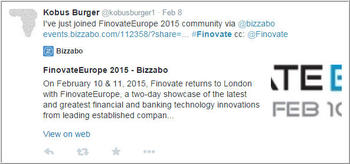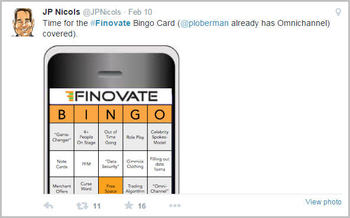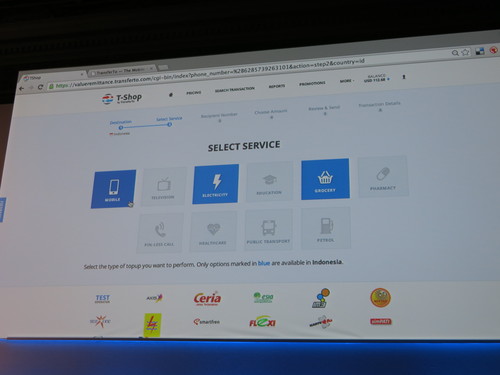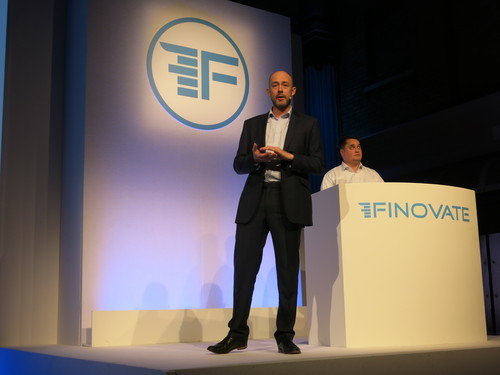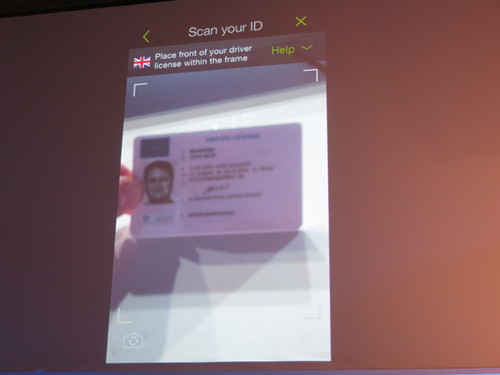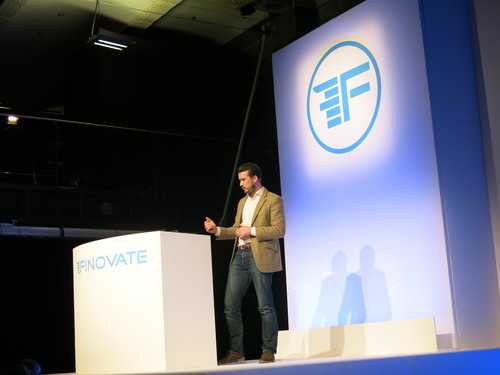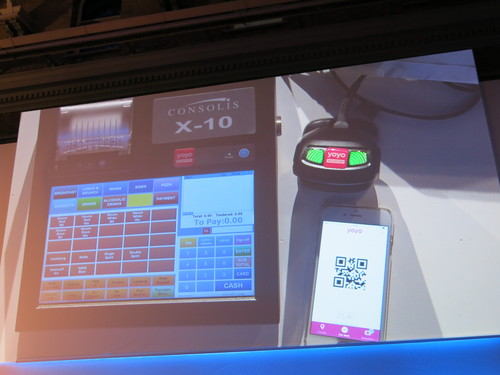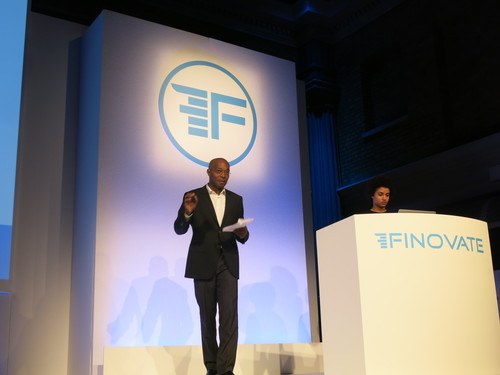 Over the years I’ve rarely been impressed with the confirmation pages displayed after a user takes an action, especially completing an online loan or product application. Today, I came across a good example of a post-sale confirmation screen from RedBubble (see screenshot below), an online purveyor of smartphone cases, laptop skins, and so on (see inset).
Over the years I’ve rarely been impressed with the confirmation pages displayed after a user takes an action, especially completing an online loan or product application. Today, I came across a good example of a post-sale confirmation screen from RedBubble (see screenshot below), an online purveyor of smartphone cases, laptop skins, and so on (see inset).
Bill.com Raises $50 Million, Doubling Total Funding
In a round led by Silicon Valley Bank and featuring participation from current investors, Bill.com has added $50 million in new capital.
The investment takes the company’s total funding to more than $120 million.

Because most businesses still rely on manual processes for accounts payable and accounts receivable, Bill.com CEO and founder René Lacerte believes there is a “significant market opportunity” for Bill.com and its banking partners. Jacob Moseley, senior market manager for Silicon Valley Bank, praised Bill.com’s growth and put the company “at the center of the digital payments space.”
“Bill.com tackles a problem that plagues small business,” Moseley says, “and distills it down to a simple solution for paying bills and getting paid.”
Existing investors also participating in the round were:
- American Express Ventures
- August Capital
- Commerce Ventures
- DCM Ventures
- Napier Park Global Capital
- Scale Venture Partners
Lacerte said the funding will help the company grow its core technology and offer its services across the United States.
Forbes.com contributor, Ben Kepes writes “that’s a lot of cash for something as unsexy as bills.” But the investment strongly suggests that sexy is as sexy does. According to the company, Bill.com is used by three of the top-10 U.S. banks and 35 of the top-100 accounting firms, and is seated “at the intersection point between banks, the accounting software providers, and businesses.” More than 600,000 network members use the technology to process more than $19 billion in payments a year.
CNBC’s coverage of the funding includes a breakdown of Bill.com’s previous funding rounds, as well as a peek into the company’s growth plans (190 employees by the end of 2015, up from the current 140), and potential IPO (“two to three years” away). The CNBC column quotes Mozilla CFO Jim Cook, whose company spends “thousands of dollars a month” on the technology, citing both cost-savings and a superior audit trail as reasons why he finds the technology “easier and more robust.”
Founded in 2006 and headquartered in Palo Alto, California, Bill.com demoed its technology as part of FinovateSpring 2012.
FinovateEurope 2015: Tweets by the Thames
Our biggest FinovateEurope to date is in the books. Thanks to all our presenters, sponsors, partners, and, of course, our record-setting attendees.
A special thanks to our scribes in social media. Our Twitter feed (#Finovate) continues to be a great way to hear and be heard—from the first demo on Tuesday through the naming of the Best of Show winners Wednesday afternoon. Here’s a sampler of some of the more colorful commentary and insightful observations from FinovateEurope 2015.
Thanks to everyone who participated and we’ll see you in San Jose for FinovateSpring 2015 in San Jose!
Alumni News—February 17, 2015
 Top Image Systems partners with Hanse Orga to offer capture-enabled accounts receivable payment processing for SAP & ERP.
Top Image Systems partners with Hanse Orga to offer capture-enabled accounts receivable payment processing for SAP & ERP.
- QuantConnect LEAN Engine now 100% open source.
- JetPay to support WePay’s launch in Canada.
- LifePay acquires iboxPro, expands into Asian markets.
- PYMNTS features LendUp.
- Fast Company names Motif, Likefolio, Fidor Bank, LendUp, Blooom, and LearnVest in the top innovative companies of 2015 in personal finance.
- PluraVida selects Dwolla to process transactions between media suppliers and buyers.
- CNBC interviews CEO Michael Carter, BizEquity, on its business-valuation service.
Fintech Fundings: 13 Companies Raise $700 Million Week Ending Feb 13

It was another blockbuster week with 13 companies raising a total of $695 million. However, $500 million of that was not a pure fintech play, as China’s Ant Financial (which runs Alipay) took at 25% stake in Indian mobile payments and ecommerce hub, One97, which runs Paytm. Even without that gargantuan deal, there was still $200 million invested into the sector, with $125 million of that (63%) put into the lending sector and $61 million (31%) earmarked for billing and payments.
The total included one Finovate alum, AdviceGames ($570,000), which demoed at last week’s FinovateEurope (demo videos will be available at Finovate.com by the end of the month).
Here are deals by size announced between 7 Feb and 13 Feb 2015 (in order of magnitude):
One97
Indian mobile payments and commerce hub
Latest round: $500 million
Total raised: $534 million
Tags: Paytm (brand), mobile payments, bill payment, ecommerce, Ant Financial/Alipay (investor), Noida, India
Source: FT Partners
Oportun (formerly Progreso Financiero)
Online lender
Latest round: $90 million
Total raised: $213 million ($30 million is debt)
Tags: Credit, lending, unsecured, underbanked, Menlo Park, California
Source: Crunchbase
Bill.com
SMB invoicing and payments platform
Latest round: $50 million
Total raised: $122.6 million
Tags: Billing, invoicing, accounts payables, bill payment, SMB, Palo Alto, California, Finovate alum
Source: Crunchbase
Borro
Online loans secured by luxury assets
Latest round: $19 million
Total raised: $171.6 million
Tags: Secured lending, underwriting, credit, pawn, London, UK
Source: Crunchbase
CapitalFloat
Online lender to SMBs in India
Latest round: $13 million
Total raised: $16 million
Tags: Lending, credit, underwriting, SMB, India
Source: Crunchbase
MineralTree
SMB billpay and invoicing tools
Latest round: $11.1 million
Total raised: $18.9 million
Tags: Payments, mobile, SMB, accounts receivables, bill payment, Cambridge, Massachusetts
Source: Crunchbase
ComparaGuru
Financial price comparison site
Latest round: $4 million
Total raised: $4 million
Tags: Lead generation, personal finance, price comparison, Mexico City
Source: FT Partners
Bento
Small banking business platform
Latest round: $2.5 million
Total raised: $2.5 million
Tags: Crowdfunding, SMB, San Francisco, California
Source: Crunchbase
InvestiQuant (formerly Master the Gap)
Specialized investing platform
Latest round: $1.5 million
Total raised: $1.5 million
Tags: Investing, fx, ETF, indices, arbitrage, quants, Morrisville, North Carolina
Source: Crunchbase
BitPesa
Nigerian digital currency exchange
Latest round: $1.1 million
Total raised: $1.7 million
Tags: Cryptocurrency, payments, bitcoin, remittances, Nairobi, Nigeria
Source: Crunchbase
Money360
Online marketplace for commercial real estate loans
Latest round: $1 million (debt)
Total raised: $3 million ($1 million is debt)
Tags: Crowdfunding, real estate, commercial lending, P2P, investing, Ladera Ranch, California
Source: Crunchbase
CoAssets
Real estate crowdfunding platform
Latest round: $800,000
Total raised: $800,000
Tags: Crowdfunding, peer-to-peer lending, credit, P2P, SMB, Singapore
Source: Crunchbase
AdviceGames
Financial gamification software
Latest round: $570,000
Total raised: Unknown
Tags: Gamification, personal finance, youth banking, Hilversum, Netherlands, Finovate alum
Source: Finovate
Alumni News, February 13, 2015
 Digital Insight to offer its customers EyePrint ID, courtesy of new agreement with EyeVerify.
Digital Insight to offer its customers EyePrint ID, courtesy of new agreement with EyeVerify.
- Global Debt Registry unveils new asset classes, new resources, and new UI in brand refresh.
- Azimo extends its money-transfer service to Thailand.
- FinovateEurope 2015 Best of Show Winners announced.
- Fast Company features Ayasdi in its list of the Top 10 Most Innovative Companies of 2015 in Big Data.
- 22 Finovate alums nominated for 2015 Pymnts innovator awards. Cast your vote here.
- Lincoln Savings Bank hires Insuritas to launch insurance agency for its customers.
- FreeAgent partners with Appointedd to simplify small business bookings.
- Bank Innovation takes a look at the widespread use of Xignite APIs among fintech startups.
FinovateEurope 2015 Best of Show Winners Announced
If there is anything more exciting than the first Finovate conference of the year, it’s seeing who will be the year’s first Best of Show award-winning companies.
After two days of fintech presentations and demonstrations, our audience of more than 1,100 has shared its opinion on which technologies at FinovateEurope 2015 stood out from the rest of a truly impressive pack.
Notes on methodology:
LifePay Presents its mPOS, EMV, Chip and Pin Technology for SMEs
 This post is part of our live coverage of FinovateEurope 2015.
This post is part of our live coverage of FinovateEurope 2015.
We created LifePay to merge all of our products into one ecosystem that will support B2B and B2C financial services through the entire customer journey for both merchants and individuals.
LifePay is rolling out business solutions to new markets in Asia and Europe, including:
- mPOS
- Cash Register with LifePad and MDM system
- Merchant portal with CRM and sales analytics
- Online acquiring
- Credits for merchants
- POS credits for individuals
Presenters: CMO Anna Yanchevskaya; Vlad Pyatak, manager of special events; Anna Filatova, marketing specialist
TransferTo’s Remittance Service Enables the Sender to Know How the Money is Spent
 This post is part of our live coverage of FinovateEurope 2015.
This post is part of our live coverage of FinovateEurope 2015.
TransferTo showed how its Prepaid Electricity Remittance gives the sender more control over how recipients spend their money.
A major and recurring issue with money remittance is the sender not knowing how their money is spent.
TransferTo has developed a new service to overcome this problem whereby the sender can remit value for a specific purpose. We call it Value Remittance. TransferTo works directly with service providers to enable remote payment for services such as utilities, petrol, healthcare, school tuition, groceries, etc.
A great example of this is the Prepaid Electricity in Indonesia. Indonesian migrant workers in the Middle East send millions of rupees back to their families. Instead of sending money, TransferTo enables them to remotely top up the Prepaid Electricity meter of their loved ones back home.
Presenters: CEO Eric Barbier, and EVP Charles Damen, global business development
Product distribution strategy: Direct to Business (B2B)
HQ: San Francisco, California, U.S.A.
Founded: 2005
Website: transfer-to.com
Twitter: @TransferTo
Jumio’s Netverify Makes Mobile Account Opening Easy
 This post is part of our live coverage of FinovateEurope 2015.
This post is part of our live coverage of FinovateEurope 2015.
Jumio showed how Netverify makes it quick and easy for customers to open new accounts on their mobile device.
Jumio’s Netverify turns your customer’s mobile device into an ID-document-scanning terminal that instantly sees, scans, and extracts name and date of birth, and if present, address data. The data is instantly and neatly populated into the account-opening fields, making it quicker and easier for customers to complete applications.
Jumio also authenticates the ID document by determining that it is a bonafide, non-manipulated, and legitimate government-issued ID.
Account opening can be completed instantly so that customer sign-up momentum is not broken when a customer is asked to provide physical copies of ID documents.
Product launch: 2012
Metrics: 300+ employees; $60 million raised; half of the top-10 consumer internet companies along with hundreds of other retailers, financial institutions, marketplaces, gaming companies and more have adopted Jumio products and services
Product distribution strategy: Direct to Business (B2B), through other fintech companies and platforms
HQ: Palo Alto, California, U.S.A.
Founded: 2010
Website: jumio.com
Twitter: @jumio
Yoyo’s Mobile Payments App Rewards Customers While Providing Retailers with Analytics
![]() This post is part of our live coverage of FinovateEurope 2015.
This post is part of our live coverage of FinovateEurope 2015.
Yoyo showed how its mobile payments app rewards consumers and offers retailers added benefits.
Yoyo integrates into the retailer’s till system and uses a unique QR code for each transaction, which is scanned at the point of sale. For consumers, it’s a quick and easy way to pay and get rewarded. For retailers, Yoyo provides a set of tools which enables them to better target their customers with relevant rewards, offers, and incentives.
We recently launched V3 of the Yoyo app, and we are constantly introducing new product features. Most recent additions include social gifting, digitalized receipts, and card to mobile.
Product launch: V1 app launched January 2014, V3 launched September 2014
Metrics: $5M seed funding raised to date, 25 employees, around 15,000 registered users since launch in January 2014, currently processing 80,000 transactions a month
Product distribution strategy: Direct to Consumer (B2C), Direct to Business (B2B)
HQ: London, United Kingdom
Founded: May 2013
Website: justyoyo.com
Twitter: @justyoyo
KPAX Provides Strategic Automated Regression Testing and Reconciliation for Financial Services Businesses
 This post is part of our live coverage of FinovateEurope 2015.
This post is part of our live coverage of FinovateEurope 2015.
KPAX is a powerful tool developed for strategic automated regression testing and reconciliations for financial services as well as data users in other sectors. KPAX automatically runs comparisons between data sets, thereby removing manual processing and providing an advance in the speed and quality of data.
KPAX can be installed as a virtual machine, on servers, or via the cloud.



